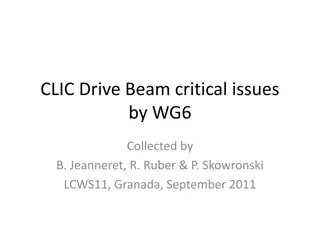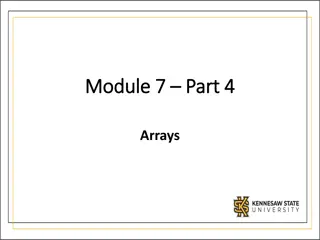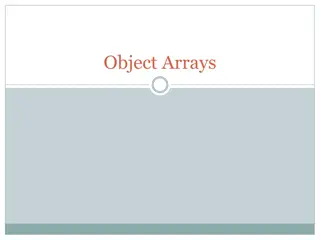Understanding Arrays: Overview and Examples
Arrays are essential data structures used to store collections of data in programming. They can be one-dimensional, two-dimensional, or multidimensional, accessed by specific indices. Learn about linear arrays, indexing methods, and two-dimensional arrays through detailed explanations and visual rep
1 views • 33 slides
Arrays as Pointers: Fundamentals of Computing
Explore the concept of using arrays as pointers in the context of computing. Learn how to create array of char pointers to store multiple strings, access elements in arrays of pointers, and understand the rules for accessing individual elements. Discover the nuances of pointer manipulation and array
1 views • 10 slides
Working with JavaScript Arrays: Storing and Accessing Data
Arrays in JavaScript serve as containers to hold multiple values like strings, numbers, and booleans within a single variable. They provide a more efficient way to store and manage data compared to using individual variables for each value. The guide covers creating arrays, initializing them, access
0 views • 13 slides
Understanding Arrays and Number Relationships for Learning Math
Explore the concepts of arrays, commutativity, factors, primes, squares, and multiplication strategies for building arrays. Delve into understanding rows, columns, and various ways to calculate products efficiently. Discover how to make arrays using counters and learn about prime numbers and factor
0 views • 10 slides
Understanding Arrays in Data Structures Using C
Arrays in C are collections of data elements with the same data type stored in consecutive memory locations. This chapter covers array declaration, accessing elements, storing values, operations, passing arrays to functions, pointers, two-dimensional arrays, and more. Arrays are accessed using indic
3 views • 80 slides
Understanding Two-Dimensional Arrays in Java Programming
Explore the concept of two-dimensional arrays in Java programming through examples and illustrations. Learn how to declare, create, and initialize two-dimensional arrays efficiently to represent matrices or tables. Discover the benefits of using multi-dimensional arrays for data organization and man
1 views • 25 slides
Innovations in RF Source Topologies and Modeling for Enhanced Efficiency
Explore novel RF source topologies and advanced modeling techniques to achieve higher efficiency and power density in RF systems. Discover tradeoffs, multi-beam arrays, radial beam klystrons, and deflected beam amplifiers for improved performance in high-power applications.
0 views • 15 slides
Advancements in Beam Dynamics and Simulation at John Adams Institute
Explore the latest research highlights in beam dynamics and simulation conducted by Stewart T. Boogert at the John Adams Institute in collaboration with Royal Holloway. Learn about the groundbreaking work in wakefield measurement, achieving a beam size of 65 nm, development of beam delivery simulati
0 views • 15 slides
Critical Issues in CLIC Drive Beam by Working Group 6 at LCWS11
Issues identified in the CLIC Drive Beam project include RF stability and reliability, beam current stability, RF deflectors in combiner rings, synchrotron radiation power, beam dynamics, operability concerns, machine protection, and beam synchronization challenges. Key areas requiring attention inc
0 views • 5 slides
Beam-beam Effects in Future Hadron Colliders Workshop
Explore the beam-beam effects in the SPPC and future hadron colliders, presented at the International Workshop on High Energy Circular Electron-Positron Colliders. The workshop covers weak-strong beam-beam simulations, collision models, and parameter values for the SPPC. Detailed discussions on the
0 views • 32 slides
Analysis of Beam Tracking in IEEE 802.11-19/0007r0 Document
The document "January 2019.doc: IEEE 802.11-19/0007r0" discusses the necessity of beam tracking in the 11md draft. It explores whether beam tracking should be mandatory or optional and provides insights into DMG beam tracking procedures for both TX and RX in wireless communication. The document emph
0 views • 11 slides
Revolutionizing Oral Care with Beam Connected Toothbrush and Insurance Plan
Beam Technologies offers the Beam Brush, a smart toothbrush that integrates with a dental insurance plan to promote preventative oral care, reduce costs, and provide valuable insights on oral health. The Beam Brush and accompanying app track and reward good oral hygiene habits, detect oral diseases,
0 views • 5 slides
Advanced Beam Diagnostics and Control Systems in Beam Physics
Cutting-edge detector technologies like KAPTURE and KALYPSO are revolutionizing beam diagnostics with ultra-fast Terahertz detectors and advanced line-camera systems. The POF III and POF IV projects focus on extreme beam control and diagnostics, aiming to probe femto-scale dynamics of relativistic p
0 views • 8 slides
Overview of Electron/Positron Injector Linac Upgrades at KEK
The recent status of the Electron/Positron Injector Linac at KEK, presented by Kazuro Furukawa, highlights the mission to achieve 40 times higher luminosity in the SuperKEKB collider. The upgrades include low emittance, low energy spread injection beams with higher beam current, new high-current pho
0 views • 23 slides
Understanding Arrays in CS1600: A Comprehensive Review
Working with arrays in CS1600 involves essential concepts like declaring arrays, array variables, variable types, and usage of indexed variables. Arrays provide a structured way to store and process collections of data of the same type efficiently. Mastering array basics is crucial for effective pro
0 views • 83 slides
Ion Beam Intensity Enhancement Through Electron Heating in Collider Experiments
The study discusses electron heating of ions in collider experiments at the Collider V. ParkhomchukBINP facility in Novosibirsk. It explores the effects of electron cooling on ion beams, ion beam oscillations, losses, and ion beam intensity enhancement. Various factors such as ion charge, classical
0 views • 9 slides
Highlights of the 65th ICFA Advanced Beam Dynamics Workshop
The 65th ICFA Advanced Beam Dynamics Workshop featured insightful presentations on high currents, luminosity, and beam behaviors. Topics included beam pipe scrubbing, non-gaussian beam tails, and detector backgrounds. Presenters discussed progress in FCCee design, focus magnets, and beampipe concept
0 views • 32 slides
Achieving High Average Beam Polarization in Particle Colliders
Detailed discussion on achieving high average beam polarization in particle colliders like CEPC, focusing on longitudinal polarized colliding beams, beam polarization requirements, basic formulas, and strategies for maintaining beam polarization during physics runs. Emphasis on scenarios involving s
0 views • 16 slides
ESSnuSB Project - Linac Upgrade for Neutrino Beam Generation
Explore the ESSnuSB project's linac upgrade featuring beam pulsing schemes and modifications, aiming to provide an additional 5 MW of beam power for neutrino generation. The upgrade options, pulse structure, beam parameters at 2.5 GeV, and different pulsing schemes are detailed with images and descr
0 views • 10 slides
Multi-Stage, Multi-Resolution Beamforming Training for IEEE 802.11ay
In September 2016, a proposal was introduced to enhance the beamforming training procedures in IEEE 802.11ay for increased efficiency and MIMO support. The proposal suggests a multi-stage, multi-resolution beamforming training framework to improve efficiency in scenarios with high-resolution beams a
0 views • 11 slides
Electron Lenses in Particle Accelerators: Advancements and Applications
Explore the use of electron lenses in particle accelerators for space-charge compensation, Landau damping, halo collimation, and beam-beam compensation. Learn about their history, applications in Tevatron and RHIC colliders, and current research areas. Electron lenses have shown promise in enhancing
0 views • 44 slides
Update on UE Beam Assumption for RRM Test Cases in 3GPP Meetings
The latest developments in 3GPP meetings regarding UE beam assumption for RRM test cases are outlined. Discussions include the need for UE beam type assumptions, updates to test cases for FR2, and upcoming presentations focusing on specific test cases and beam assumptions per test group. Test purpos
0 views • 9 slides
Understanding Arrays and Linked Lists in Computer Science
Arrays and linked lists are fundamental data structures in computer science. Arrays provide a fixed-size collection, while linked lists offer dynamic sizing. Arrays are efficient for accessing elements but can be inefficient for insertions and deletions. Linked lists, on the other hand, allow for ea
0 views • 42 slides
Understanding Group Structures and Arrays in Multiplication
Explore the foundational concepts of grouping and arrays in multiplication through activities designed to help students describe quantities arranged in equal groups or arrays. Teacher directions, examples for modeling arrays, and additional activity prompts are provided to support students in interp
0 views • 56 slides
Introduction to Arrays in Computer Science
Explore the concept of arrays in computer science, a special type of variable that can hold collections of elements of the same type. Learn about the characteristics of arrays, how to declare and initialize them, and see examples of specifying array sizes. Develop a foundational understanding of arr
0 views • 19 slides
Overview of Mu2e Slow Extraction Workshop at Fermilab by Vladimir Nagaslaev
This content discusses the Mu2e project at Fermilab, focusing on slow extraction techniques for beam delivery. It covers beam facilities, characteristics of Muon Campus, design requirements, beam losses, new MARS simulations, and losses in the extraction beam line. Details include beam kinetics, spi
0 views • 17 slides
Understanding Arrays of Objects in Programming
This lecture delves into the concept of arrays of objects, showcasing multi-dimensional arrays and discussing the steps involved in handling arrays of primitive types versus arrays of objects in Java programming. It includes insights on declaring, creating, and populating arrays, along with a practi
0 views • 22 slides
Understanding Arrays in Java: Basics and Operations
Java arrays are fixed-size collections that can only hold a single data type. They require manual checking for elements and cannot be sliced like Python lists. Operations such as resizing, searching, printing, comparing, and slicing arrays need to be done manually. Remember, the array size must be d
0 views • 14 slides
Understanding Arrays of Objects and Primitive Types
Arrays of objects provide a way to store and manage multiple instances of complex data types, similar to arrays of primitive types. This content explores the concept of arrays of objects, how to declare and allocate memory for them, and how to work with arrays of primitive types like double and int.
0 views • 25 slides
Basics of Java Arrays and Array Manipulation
Learn about the fundamentals of Java arrays, including initialization, literals, indexing, and the special value of null. Explore how arrays function as reference types and how array cloning can be used to create shallow copies. Understand the implications of passing arrays to methods and how change
0 views • 44 slides
Overview of CAIN Particle Tracking Code for High-Energy Colliders
CAIN is a particle tracking code used for high-energy collider simulations since 1984. Initially named ABEL, it evolved to include beam-laser interactions for gamma-gamma colliders. The code, written in FORTRAN 90, handles beam-beam and external fields, with a structure where all particles are store
0 views • 17 slides
Understanding Arrays in Computer Programming
Arrays in programming are collections of elements that have the same data type. Elements in an array are accessed using integer-valued indices. Arrays inescapably play a crucial role in programming as they allow for efficient storage and manipulation of data. Initialization, declaration, and utiliza
0 views • 14 slides
Design of a 10 MeV Beamline for E-beam Irradiation at UITF Wastewater Facility
This paper discusses the design of a 10 MeV beamline at the Upgraded Injector Test Facility for electron beam irradiation, focusing on wastewater treatment for environmental restoration. The use of electron beam irradiation is highlighted as an effective method to remove pollutants like 1,4 dioxane
0 views • 9 slides
Machine Learning Applications for EBIS Beam Intensity and RHIC Luminosity Maximization
This presentation discusses the application of machine learning for optimizing EBIS beam intensity and RHIC luminosity. It covers topics such as motivation, EBIS beam intensity optimization, luminosity optimization, and outlines the plan and summary of the project. Collaborators from MSU, LBNL, and
0 views • 23 slides
Linear Antenna Arrays: Theory and Applications
Introduction to linear antenna arrays, including the concept of distributing radiating elements, combining array elements for specific beam characteristics, and the theory behind linear antenna arrays. Exploring the benefits of linear arrays in obtaining narrow beams, fan beams, and scanning capabil
0 views • 20 slides
Understanding Arrays in PHP Programming
Arrays in PHP play a crucial role in storing and manipulating data efficiently. This snippet demonstrates the use of numerical and associative arrays, modifying elements, removing array elements, retrieving array size, handling nested arrays, and processing arrays with loops in PHP. Explore various
0 views • 9 slides
Understanding Arrays in C Programming: Unit 8
Arrays are essential for efficient programming in C. In this unit, Aaron Tan from NUS provides valuable insights into arrays, including their concept, application, and problem-solving techniques. The unit covers array pointers, declarations, variable initializers, assignments, parameters in function
0 views • 42 slides
Challenges and Design of High-Intensity Accumulator for Neutrino Experiments
The presentation discusses the challenges faced in designing an accumulator for high-intensity particle beams in neutrino experiments at ESS Lund, with a focus on beam loss management, injection efficiency, and intense beam physics issues. The design considerations include beam holding capacity, bea
0 views • 30 slides
Introduction to Arrays and Recursion in C++
Arrays and recursion play a vital role in designing algorithms on sequences in programming. This introduction covers the implementation of searching in arrays, binary search, merge sort, and the concept of searching in sorted arrays using recursion. The use of recursion helps reduce comparisons and
0 views • 49 slides
Advanced Python Programming: Arrays, Exceptions, and More
Explore advanced programming topics in Python, including arrays of multiple dimensions, Python built-in types like tuples and dictionaries, and handling exceptions. Dive into representational challenges like those in Minesweeper and Hangman, and discover the significance of arrays in programming. Le
0 views • 31 slides





































